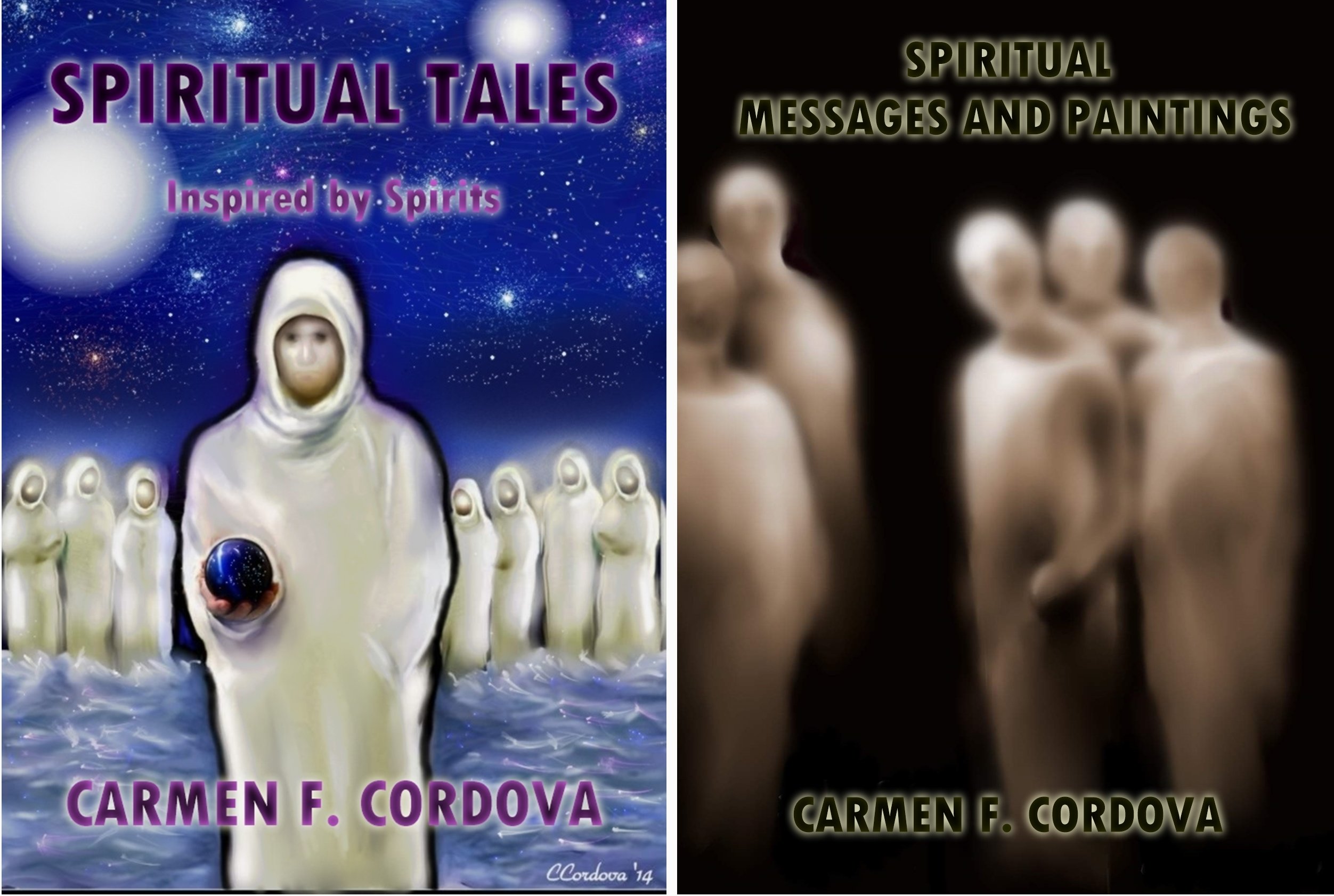Brazilian Umbanda
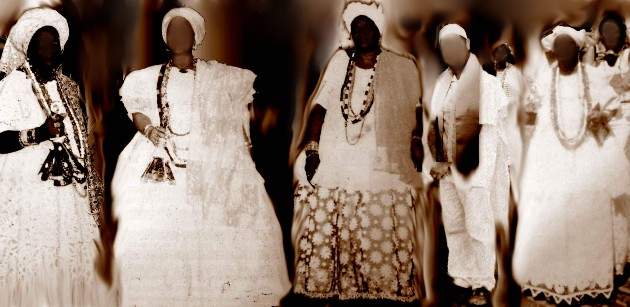 Brazilian Umbanda
Brazilian UmbandaBrazilian Umbanda
Afro-Brazilian Religion
Afro-Brazilian religions are a testament to the cultural resilience and creativity of enslaved Africans and their descendants. Despite the brutal conditions of slavery, African people managed to maintain their cultural heritage and adapt it to the new environment. They blended their traditional beliefs and practices with elements from European and Native American cultures, creating a unique syncretic religious landscape. This blending of cultures is evident in the use of Catholic saints, African deities, and indigenous rituals in Afro-Brazilian religions. The result is a rich and diverse spiritual tradition that continues to thrive in Brazil today.
Umbanda and Candomblé, are Afro-Brazilian religions with deep African roots and historical ties to African traditions. It is a syncretic religion that blends African beliefs with elements of Catholicism and indigenous traditions. The religions are known for its rich rituals, music, and dance, which are integral to its practice.
According to Wikipedia, "Umbanda is a relatively new Afro Brazilian religion that emerged in Rio de Janeiro, Brazil in the 1920s. It derives largely from Spiritism with a mixture of elements from Afro-Brazilian traditions like Candomble as well as Roman Catholicism."
By blending all three elements -spiritism, African traditions, and Catholicism, it has created its own unique identity.
David St. Clair, in his book Drum and Candle, wrote about Umbanda, “…more sophisticated than African ritual and more understandable than French-implanted Spiritism.”
Candomblé's origins can be traced back to various African countries, particularly Nigeria and Togo. The enslaved people from these regions brought their diverse traditions and beliefs, which significantly influenced the formation of Candomblé's practices and rituals. African culture plays a crucial role in shaping Afro-Brazilian religions, including Candomblé and Umbanda, highlighting the deep connections to the specific African cultures from which they originated. The religion's diverse practices and the names associated with its rituals reflect this rich cultural heritage.
In Candomblé rituals, animal sacrifice plays a vital role and is often misunderstood due to cultural and racial prejudices.
Candomblé practitioners in Brazil have historically faced discrimination, persecution, and societal misconceptions. Recent movements have aimed for recognition and acceptance, highlighting the spiritual practices and cultural significance of the religion
Umbanda- Afro-Brazilian practices
As mentioned previously, Umbanda emerged in the early 20th century in Rio de Janeiro, Brazil. It combines elements from African religions, Spiritism, and Roman Catholic religion, creating a unique spiritual practice.
Umbanda belief system consists of a Supreme Creator, deities called Orixas, Catholic saints, spirits of the deceased, ancestors, spirit guides, reincarnation, spiritual evolution and the practices of charity and social fraternity.
Umbanda is characterized by its emphasis on spirit possession, healing, and communication with the spirit world. Umbanda has its own rituals, ceremonies, and traditions, which are distinct from those of Candomblé and other Afro-Brazilian religions. This unique blend of beliefs and practices makes Umbanda a fascinating and integral part of Brazil’s spiritual landscape.
History and Development of Umbanda
Founder of Umbanda Religion
Umbanda was founded by Zelio Fernandino de Moraes, a medium who claimed to have received messages from spirits. Umbanda quickly gained popularity among the urban poor and working-class people, who were attracted to its promises of healing, protection, and spiritual guidance. Over time, Umbanda has evolved and spread throughout Brazil, incorporating elements from other Afro-Brazilian religions and spiritual traditions. This evolution has allowed Umbanda to remain relevant and vibrant, adapting to the changing social and cultural landscape of Brazil.
According to David St. Clair (Drum and Candle), Caboclo, a spirit guide who was an Indian half-breed native Brazilian in his last incarnation, revealed to Zelio de Moraes that neither Candomble nor Spiritism, “was right and proceeded to dictate a brand-new set of rules, regulations, rituals, chants, drumbeats, herbal cures, curses, dance steps, etc.”
Umbanda in New York
Umbanda Ceremony
I was invited to attend an Umbanda ceremony. Appreciating new and adventurous journeys, I gladly accepted the invitation.
When we got there, we were welcomed by friendly smiles. We were told to have a seat.
The front of the sitting area was roped off.
Inside the forbidden area was an altar. The altar consisted of an Indian statue, a glass of water, a stone, a large necklace enclosing the mentioned items, flowers on both sides and a large piece of chalk.
The Arrival of Umbanda Practitioners
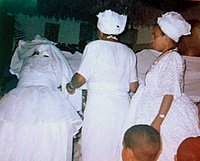
The ceremony was about to start.
Practitioners in white clothing began entering the room. The men as well as women were dressed in white pants and white shirts.
The last four individuals to enter the room were dressed in colorful attire- the women with full long skirts and the man with a colorful shirt and cap.
The people dressed in white began to take their respective places outside the roped area, while the remaining four entered the enclosed area.
One of the women began to address the visitors.
She thanked us for attending, and briefly explained what was about to happen. Without a doubt, she was the priestess in charged.
Umbanda Rituals of Singing and Dancing
In minutes, the climate of the room had changed. The practitioners began singing and dancing.
As we sat in our seats, we began to join in by clapping our hands to the rhythm of the music.
The sound began to take a stronger tone as the singers began calling out the names of Oshun and Yemaya.
The Arrival of the Spirits
Shortly after, the spirits arrived. They had taken over the bodies of the man and priestess.
Both were given chalk by their assistants. They began drawing symbols on the floor.
Each symbol represented the name of the entity that was present.
Consultation
By now, visitors were allowed to enter the forbidden area and approach one of the two possessed mediums.
I quickly got up and went to the woman. She held my hands and proceeded to talk.
Her assistant who was sitting next to her was carefully paying attention to everything that was said and done.
When the spirit demanded an item, she got it without any hesitation. It seemed to me, as if she was honored to serve spirit.
After the consultation and spiritual cleansing, I returned to my seat. When everyone had finished consulting the spirits, the spirits released themselves from the mediums’ bodies.
Before the Closing of the Ceremony
Next, the people dressed in white began entering the enclosed area.
The singing and dancing continued.
Within minutes, they were under the influence of spirit. It appeared that the spirits were not ready to depart.
I remained seated observing everything that was going on.
End of the Ceremony
After several minutes of spirit possession, the spirits started leaving their respective hosts' bodies.
Even though the ceremony had ended, the spiritual energy still lingered in the room and around us.
We expressed our gratitude to the Umbanda group and said our goodbyes.
The experience was peaceful and therapeutic.
Umbanda in Brazil, South America
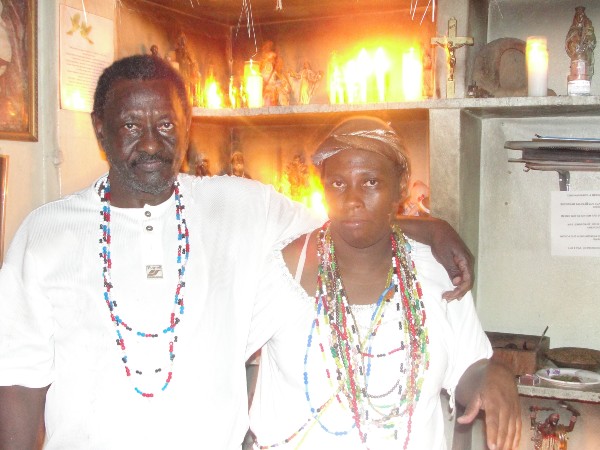 Umbanda Leaders
Umbanda LeadersThe Arrival
It was approximately 4:30 pm, when we headed out to attend an Umbanda ceremony in Goias, Brazil.
Although the trip was long, the pleasant evening breeze and panorama made the car ride quite enjoyable.
When we arrived at our destination, the driver parked in front of a modest looking house.
The front of the house was isolated. It appeared, we were the first to arrive.
The driver opened the front gate; and we proceeded to walk toward the back of the house. Upon arriving at the other side of the house, a man appeared. His name was Lazaro, a high priest.
When Lazaro saw the driver, he gave him a warm friendly hug. Lazaro and the driver were old friends who had not seen each other for several years.
After embracing and sharing pleasantries, we were introduced. Lazaro welcomed us warmly, and immediately made us feel at home.
Due to health reasons, Lazaro stated, he was no longer overseeing the activities of the Umbanda ceremony.
The responsibilities were passed down to his daughter, Irene. A few minutes later, his daughter appeared. Just like Lazaro, she welcomed us with open arms.
After a minute or two, she excused herself stating that she needed to prepare for the ceremony. Lazaro too disappeared.
Waiting for the Ceremony to Commence
As we sat waiting for the evening activities to commence, I started looking around.
Pasted on a door was a sign that stated, “A person should not practice spiritual mediumship without being fully prepared.”
My companion, who was also reading the sign, looked at me and smiled in agreement.
The Arrival of Umbanda Practitioners
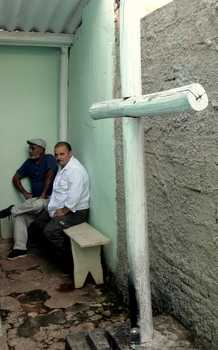
Shortly afterwards, Umbanda Practitioners began arriving.
As they marched in, they stopped and saluted a large wooden cross located next to where we were sitting.
One by one, they touched the cross and bowed their heads in homage.
After paying their respects, they entered a dressing room where they quickly changed into full Umbanda attire.
The men wore white tops and trousers, while the women wore white blouses and long skirts with a white head covering.
Both men and women had long, colorful beaded necklaces hanging from their necks.
Entering the Sacred Space
Before the commencement of the Umbanda religion ceremony, we were escorted to a room that was detached from the main house.
We were instructed to remove our shoes and sit in one of the many small benches located around the room.
It was the room where the Umbanda ceremony would take place.
The décor was similar to an African hut with dirt floors and straw dangling from the roof.
As I settled in, my attention was drawn to a large altar on the far left of the room.
It was an impressive sight, adorned with pictures of saints, statues, and unfamiliar items, all illuminated by numerous candles.
Across from the altar, a large picture of Yemaya hung on the wall.
The other walls were decorated with various spiritual images.
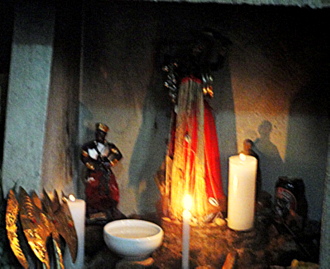
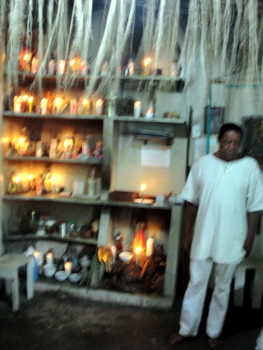 Umbanda Religious Traditions
Umbanda Religious Traditions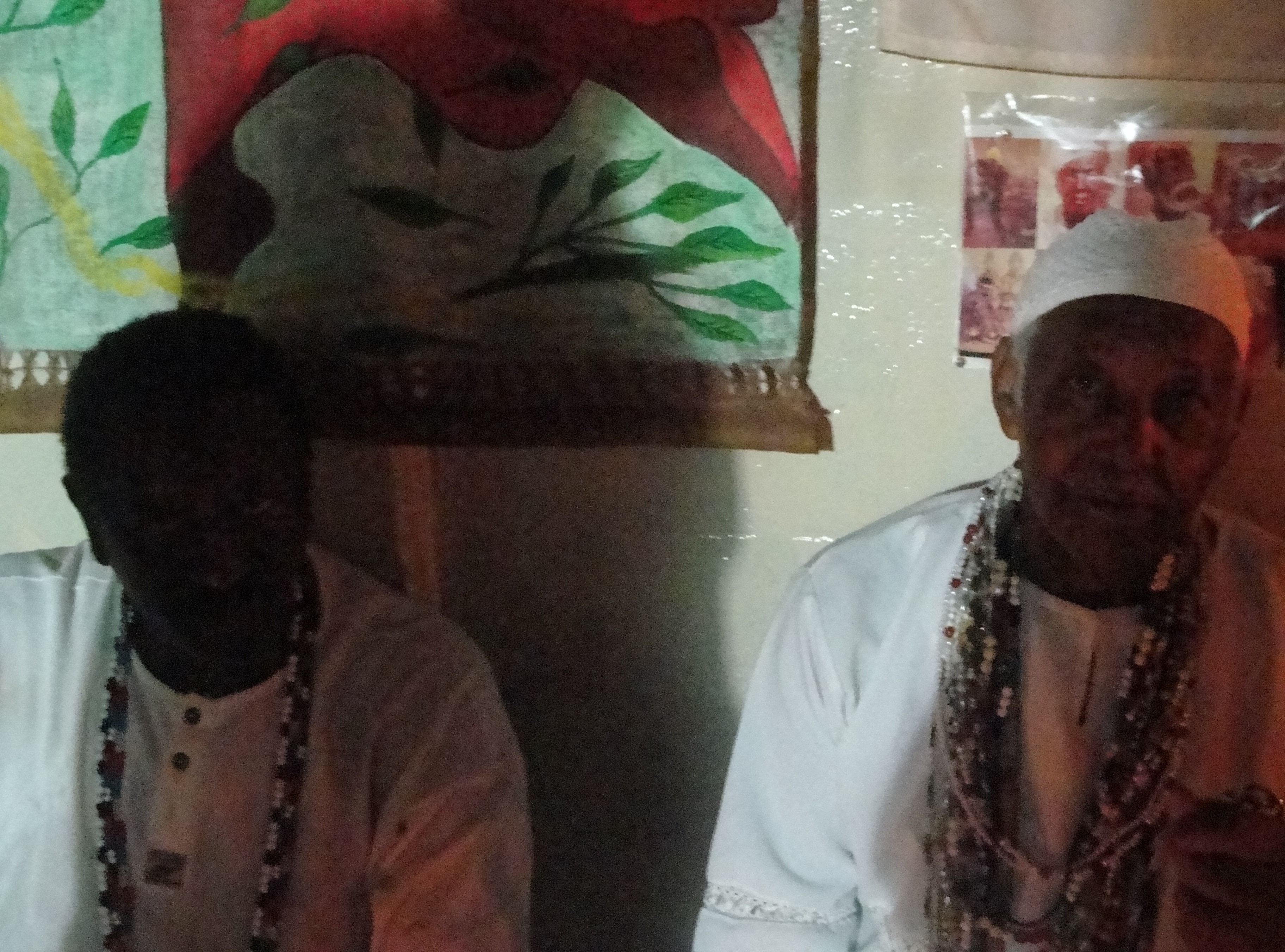
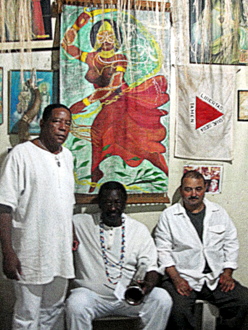
The Commencement of the Ceremony
The Umbanda practitioners dressed in white were now in the room.
Irene rang a bell as a signal that the ceremony was about to commence.
The group gathered in a circle while a woman read from a piece of paper.
The opening of the passage focused on the role of the medium, emphasizing the importance of humility and love in serving God and spiritual messengers.
The remainder of the passage centered on the values of love, compassion, and goodwill towards God, oneself, and others.
When the woman concluded reading, another woman read from another page.
"It's our duty to help each other, for we are one," she said, visibly moved by what she had read.
Suddenly, the bell rang again, indicating that it was time to start drumming. The drummer began slowly, but the rhythm picked up quickly with each beat.
The group started to sing and dance, using their songs as a way to call upon the spirits and pray for God's blessings.
The dancing and singing went on with immense energy.
As the spirits took over the bodies of the mediums, many of the dancers began to shiver and wobble, entering a trance-like state where they were no longer in control of their bodies.
I was so captivated by the transformation that I forgot to ask about the nature of the energy.
Spirits with Wooden Swords
The individuals who were possessed were handed wooden swords and proceeded to dance while swinging them in the air to the beat of the drum.
They greeted us by placing the swords on our shoulders and heads.
Upon the arrival of the entities, their vessels or hosts formed two rows. Umbanda followers were instructed to walk between them to receive a blessing from the entities.
The children were blessed first.
Following the conclusion of the blessings, we were permitted to consult with the spirits.
The Spirits of Children
After the consultation phase ended, the spirits left and the mediums started dancing and singing in the center of the room. They were trying to summon the spirits once again.
As the spirits entered their bodies, they began shaking and jerking, and this time they were spirits of children.
The spirits that appeared as children were not those who passed away young, but rather highly developed spirits who took on the form of children to bring hope and happiness.
They often assisted us in reconnecting with our inner child.
“When they talk, they always intend to cheer you up and make you look at the bright side of things.”- Wikipedia
People who were possessed by these spirits became playful and childlike, changing both their behavior and tone of voice.
They giggled and played with each other while lying on the floor.
The assistants, who helped the spirits, gave them candies to eat. Afterward, the possessed individuals stood up and shared their candies with the audience- a wonderful life lesson on sharing.
At one moment, I closed my eyes and could sense the presence of small children in the room.
While observing, Irene began tapping a stick on the floor as a signal for the spirits to exit the bodies of the mediums.
All but one spirit departed, hiding behind a drum.
Irene addressed the spirit with firm yet compassionate language until it released itself.
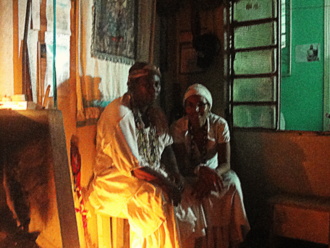
Pretos Velhos-Old Black Slaves
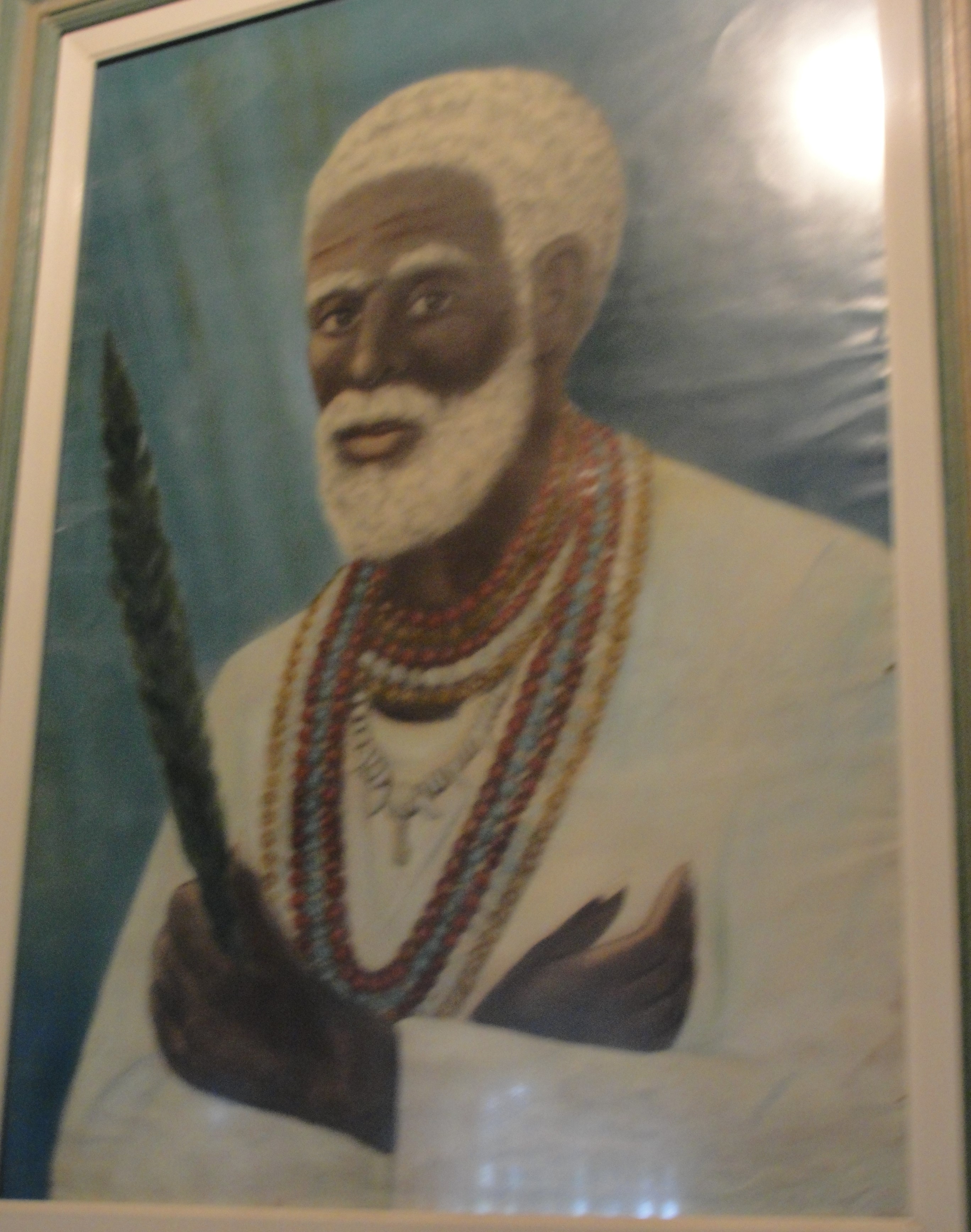
Once again, people were dancing, singing, and calling out to the spirits as the drumbeats grew with great intensity
Eventually, the spirits arrived, specifically the spirits of the Old Black African Slaves.
In the Umbanda religion, there are spirits known as the Pretos Velhos, or Old Black Slaves, who were once enslaved in Brazil.
Despite their difficult past, they are highly respected and beloved for their compassion, kindness, and expertise in herbal remedies.
Among all the spirits that appeared that night, I was particularly fascinated by the Old Black Slaves.
The mediums, who were possessed, underwent a physical transformation, taking on the traits of these spirits. It was truly remarkable to witness.
In the midst of his enthusiastic drumming, dancing, and singing, a young man suddenly became frail.
He moved slowly and was bent over, speaking in a low and shaky voice.
It appeared as though his body had been completely overtaken by a spiritual force.
The assistants provided walking sticks and pipes to the mediums who were possessed.
The mediums then leaned on their canes and made their way to their designated seats at a slow pace.
Once they arrived, they sat down and placed the unlit pipes in their mouths. One of the assistants then announced to the crowd that the entities were ready for consultation.
Amidst a crowded room filled with people eagerly anticipating the arrival of the Old Black Slaves, I approached one of the mediums who appeared to be possessed.
The noise in the room made it difficult to hear everything that was being said, but the entity's cleansing was remarkable, as I felt a surge of electricity moving through my body.
Upon returning to my seat, I was left in a state of bliss, as the energy of these entities was incredibly intense.
Yemaya
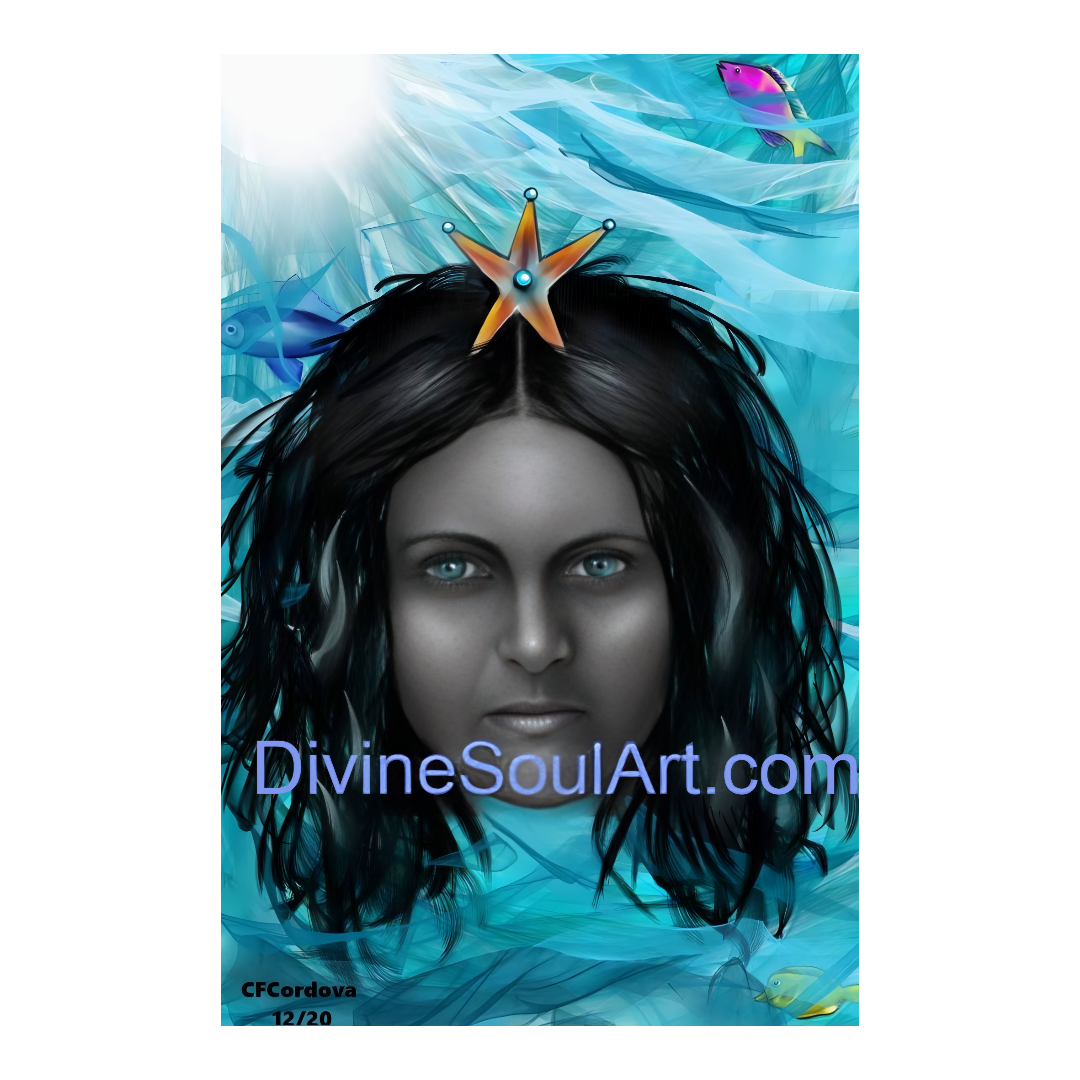
When the energy of the Old Black Slaves departed, the mediums spread out and began swaying back and forth.
Although the drumbeat continued to increase in tone, the dancers were no longer moving around the room.
One woman began dancing around in a circular motion.
She removed her headdress and let her long hair loose to hang down her back.
There was something majestic about her demeanor. It was Yemaya.
The energy of Yemaya had arrived and was now in the young woman's body.
She was given water, which she sprinkled around us. Since it was hot in the room, the water felt refreshing.
As she continued dancing and blessing us with the water, the hairs on my neck and arms stood up.
When Yemaya departed, the session ended, but her energy lingered in the air.
Yemaya, the Mother of all, had blessed us with her presence.
It was an unforgivable experience
Click below and views more than 600 pieces of spiritual artwork

Spiritual Books
If you enjoy the articles on this website, you will also appreciate the short stories in the books below. Click here and continue the journey.
